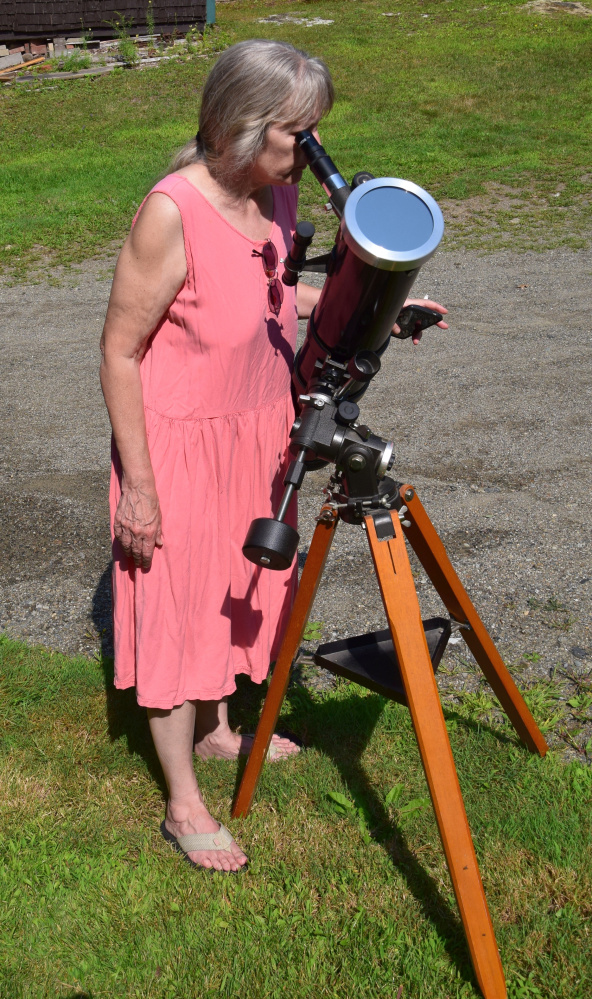Early on Monday afternoon, high thin clouds were peeling and unpeeling the blue sky. Anyway it was only a few minutes’ work to lug out the 4½-inch reflecting telescope and its wooden tripod base, set it up on the grass off the corner of the house, dust off the tube and attachments that hadn’t been used for months, and point it at the sun, which was the bright spot swimming around behind the clouds.
I screwed the eyepiece with 25x lens into its slot on the upper end of the tube, which is about a yard long. Popped the cover off the end and slid on the solar filter, which is basically a mirror that reflects back upwards of 99.9 percent of the sunlight coming at it. The thin clouds were thinning.
The sun is an easy target to line up with this heavy old-fashioned, knob-twist telescope mount. You turn the tube with your hands until it’s aimed more or less at the sun. Then you look at the telescope’s shadow on the ground and twist the two adjusting knobs until the shadow is smallest and roundest. Then you go back to the eyepiece, look one-eyed into the lens, and turn the focus knob until you have a sharp sun image.
I knew what to expect, but it startled me anyway. The sun inside the eyepiece is a bright orange disk on black. On a routine sunny day, if you study the image long enough your eye seems to detect tiny licks of orange light at the edge, but they’re so remotely small you’re never sure it’s not just an optical illusion. On Monday afternoon, though, the silent debate about reality was much larger than that. A perfectly smooth curve of black had carved out the northwest edge of the disk.
My breath kind of stuck in my throat for a second or two. Strange. In those few seconds, I partially relived the sense of awestruck bewildering doom Annie Dillard describes in her masterpiece essay “Total Eclipse,” which recounts from several angles her weirdly routine excursion to the total solar eclipse of 1979. It’s like descending too deep into a hot gold mine. It’s like a disturbing painting of a clown with vegetables for face parts. It’s like people screaming on a hillside when a wall of darkness rushes over them. It’s like being chuted into another age of the world.
That was only partially my experience in those few seconds, though, just a touch of it, there on the lawn in Troy, in the partial eclipse which (Dillard observes with better descriptive skills than mine) “bears almost no relation to a total eclipse.” Still, there was this curve of emptiness on the side of the orange disk that for a second or two unnerved me. Back to reality, quick.
Even in a partial eclipse, you take your waking slow. You can’t actually see the black moon move. But in the telescope you can see sunspots — small dark patches made from eruptions on the sun’s surface — that serve as distance markers. On Monday there was a sunspot group in about the middle of the sun and another small group on the southeast limb. So with patience, over some period of seconds, our eyes (Bonnie’s and mine) registered the moon’s progress toward the sunspots, like watching a minute hand on a watch.
You don’t actually see the moon. You see perfectly curved blackness consuming the sun. We stayed with it through totality, which here in central Maine meant about 55 percent of the disk obliterated by black. It did not get dark, like it did in the path of totality from Oregon to South Carolina, but there was a faint platinum tinge on the grass and trees, the temperature cooled just slightly, and the air filled up with flying bugs who no doubt believed dusk to be imminent.
You don’t see the moon, but if you keep track of perceptual oddities, patience inside the eyepiece can reveal a sense of depth in flatness — the moon is small and the sun is big, the space between them is expansive, 93 million miles or so, and then behind the sun is an unlimited expanse of blackness. So there gets to be a sense of disturbing depth, there, in the eyepiece. Great Nature has other things to do, and you are tiny in its cosmic gears.
I tried to take a picture of it, but don’t have the equipment.
As the platinum tinge burned slowly off the backyard, and the perfect black arc made its way like clockwork to the further edge of the orange sun, my mind stepped back to the humdrumness of it all. How these eclipses seem unusual and striking to us even though they’ve gone on every 18 months or so for 4½ billion years.
I went in the house to eat lunch. When I came back 20 minutes later to watch the black moon exit slow-motion right, I was bending to the telescope when a silvery glint caught my eye. In the few minutes I was gone, a spider had thrown a line of silk down from the corner of the house and tacked it to the eyepiece. It was wafting there in the tiny breeze, reflecting ancient light.
Dana Wilde lives in Troy. You can contact him at naturalist1@dwildepress.net. His recent book is “Summer to Fall: Notes and Numina from the Maine Woods” available from North Country Press. Backyard Naturalist appears the second and fourth Thursdays each month.
Send questions/comments to the editors.




Comments are no longer available on this story